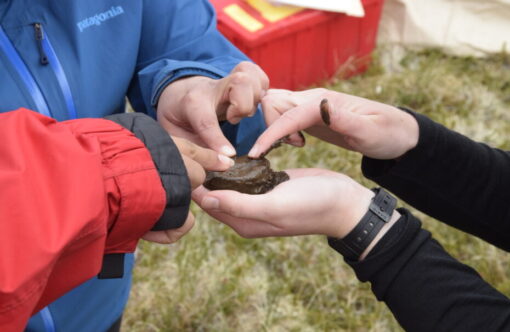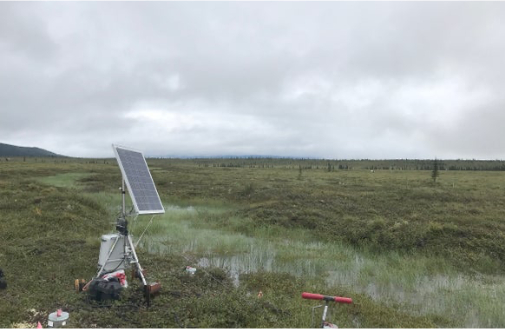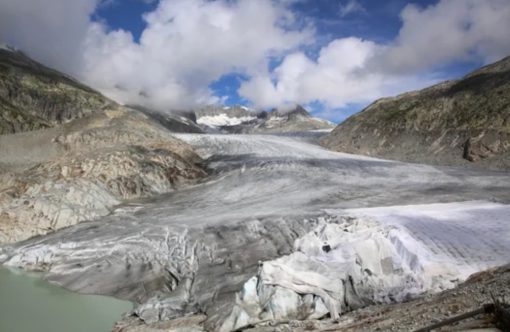Elevating the visibility of Arctic permafrost thaw in global climate negotiations
From November 6-18, 2022, members of the Permafrost Pathways team are attending the 27th Conference of the Parties of the UNFCCC (COP27) taking place in Sharm el-Sheikh, Egypt. Through participation in key side events, including Permafrost Day at the Cryosphere Pavilion (event schedule listed below), the Permafrost Pathways team aims to integrate permafrost thaw within the greater climate change discourse and to amplify the voices of the most affected Arctic communities.
Accounting for “the country of permafrost”
As the Arctic continues to warm three to four times faster than the rest of the planet, carbon-rich permafrost is thawing—triggering a powerful, greenhouse gas-emitting feedback loop with local and global ramifications. Depending on future emission scenarios, average Arctic temperatures are expected to reach 3.3-10° above the 1985-2014 average by 2100.
Despite the magnitude of this threat, international climate assessments and related policy recommendations, including the 2021 Sixth Assessment Report of the Intergovernmental Panel on Climate Change, fail to adequately account for potential emissions from permafrost thaw. As a result, the world’s policymakers are underestimating the mitigation ambition required to keep to the 1.5 or even 2.0 temperature goals of the Paris Agreement. As much as 40% of the remaining carbon budgets associated with these goals is at risk of being claimed by unaccounted-for emissions from permafrost thaw.
Advocating for Arctic justice
Rapid pan-Arctic warming and the resulting permafrost thaw is transforming northern ecosystems–often to the detriment and devastation of local communities. Hazardous conditions can not only be deadly, but can also contribute to both economic and non-economic loss and damage. In Alaska, as much as $5.5 billion worth of infrastructure is expected to be damaged due to climate change this century, and Alaska Native communities are struggling to maintain traditional ways of life amidst a changing environment. In areas most severely impacted by permafrost thaw, flooding, and coastal erosion, communities are facing imminent displacement, but lack access to affirmative funding and relocation support from governments.
Permafrost Pathways recognizes the responsibility of the scientific and policy communities to ensure equitable and just solutions to the climate crisis.

Permafrost Day in the Cryosphere Pavilion
Permafrost Pathways is proud to be a co-organizer of Permafrost Day on Friday, November 11, held in the Cryosphere Pavilion at COP27 and hosted by the International Cryosphere Climate Initiative (ICCI).
Events can be livestreamed at the links below:
Permafrost Day Schedule
Information subject to change. Event times listed in Eastern European Time (EET) and Eastern Standard Time (EST).
View the entire Cryosphere Pavilion Focus Day Schedule here.
10:00 EET/3:00 a.m. EST Co-producing adaptation strategies to the climate crisis in the Arctic (watch on-demand)
Arctic Indigenous Peoples face a complex landscape of environmental hazards due to climate change. Many communities are experiencing escalating losses and damages encompassing loss of land, cultural heritage, and local and Indigenous knowledge. How can Western scientists, Indigenous knowledge-holders, and decision-makers at COP come together to overcome the obstacles faced by adaptation efforts?
11:30 EET/4:30 a.m. EST Wildfire, abrupt thaw, and subsea permafrost: updates from the world’s fastest warming region (watch on-demand)
The Arctic is warming three times faster than the global average. This rapid warming threatens the world’s largest vulnerable carbon pool – permafrost. Understanding the global implications of permafrost thaw is of vital importance, yet critical questions remain unanswered. Here we explore the very latest developments in permafrost science and what they mean for global climate policy.
13:00 EET/6:00 a.m. EST Intergenerational justice and the runaway train of committed permafrost emissions (watch on-demand)
Thawed permafrost begins to release carbon – and will continue to do so for centuries. This means that every fraction of a degree increase in global average temperature commits future generations to an ever-increasing burden of permafrost emissions – and an ever-increasing demand for carbon drawdown. Here we address the scale of this intergenerational and geographic climate justice issue.
14:30 EET/7:30 a.m. EST Tipping points in permafrost systems (watch on-demand)
Changes across the permafrost region risk accelerating climate change, but do they also increase the likelihood of crossing thresholds that signal abrupt, even irreversible, change? Can we predict where those thresholds may lie, and what should the policy responses be? In this cross-cutting session we examine current knowledge and policy implications regarding tipping points.
16:00 EET/9:00 a.m. EST The ‘Country of Permafrost’ is the major emitter missing from COP (watch on-demand)
Permafrost stores more than twice as much carbon as every tree on the planet combined. Warming is already causing this frozen ground to thaw, threatening the vast store of carbon found there. On our current warming trajectory, permafrost emissions may rival those of major economies in just a few decades – yet no nation is counting these emissions. What does this mean for the Paris Agreement goals?
Connect with us at COP
Resources
- Loss and damage in the circumpolar North
- The State of the Cryosphere Report 2021
- Incorporating permafrost into climate mitigation and adaptation policy
- What is permafrost?
- We must stop fossil fuel emissions to protect permafrost ecosystems
- Woodwell Climate Research Center’s Dr. Sue Natali testifies to House Committee on Science, Space, and Technology
- The critical missing expense in global climate budgets
- What can be done about permafrost thaw?
- Review of permafrost science in IPCC’s AR6 WG2
- Permafrost and Climate Change: Carbon Cycle Feedbacks From the Warming Arctic
- Arctic Thaw App




